Content created: 2011-02-01
File last modified:

Chinese Symbols of Happiness
China has a rich tradition of decorating household items with up-beat symbols, and it is helpful to be able to recognize some of the commonest ones when they appear on Chinese products. There are four particularly important broad themes, in order of frequency:
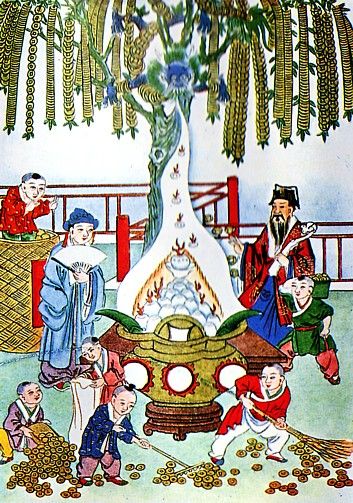
- Fecundity and children. Often children are used as a symbol of general contentment and good fortune, and thus overlap with harmony. The character fú 福, glossed “happiness,” “blessings,” “felicity,” or “good luck,” appears over and over as a decorative motif. It is commonly woven into cloth, sometimes in as many as a hundred different writings. Similarly, some folk art shows hundreds of children.
- Money, sometimes directly represented as ingots or coins, sometimes obliquely suggested through symbols of high position (since the road to wealth tended to be through public office). Especially at New Year and especially in commercial establishments, decorations intended to “call in money” are common. The "money tree" shown here with coins for leaves is from a South Chinese print shop but has been widely copied. In south China, orange, tangerine, and kumquat trees are all associated with money at New Year, although the linguistic puns involved are, well, involved. (Click here for an exasperated excursus about that.)
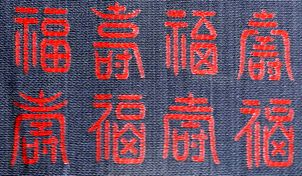
- Longevity (long life). The character shòu 寿/壽 is a common decorative motif (usually in its more complex form —the blue one).
Like fú, the character shòu is also frequently woven into cloth. For both of these characters, conventional distortions of them have become standard for decorative use. An example can be seen in the commercial embroidery shown here. (Reading from left to right, book fashion, it reads fú shòu fú shòu in the first line, and shòu fú shòu fú in the second.) But calligraphers have sometimes created works displaying either of these characters in up to a hundred minor variants.
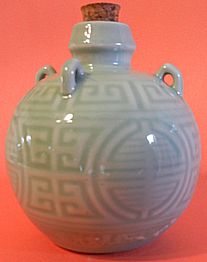
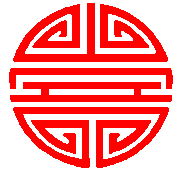
The red circular design at left is probably the most common conventional artistic variant of shòu for such purposes. Another conventionalized variant shows the top and/or bottom flared out, as in the embroidery above. Both a round and a flared version are visible on the ceramic liquor bottle shown here.
Also very closely associated with longevity are, of course, the beloved Eight Immortals, whose pictures or whose eight iconic symbols are also widely used. Because of this, an image of a flute, for example, or a sword or a vase of flowers, through the association with those figures, can become a symbol of longevity. Stories and emblems of the Eight Immortals are available on this web site. (Link) Some of the stories have spin-offs that have generated additional figures now associated with happiness, most conspicuously Liú Hǎichán 刘海蟾 and his three-footed toad, associated with the fortuitous appearance of money to true believers. (Story)
- Harmony, especially within the family. This is sometimes represented by two scruffy-looking, contemplative poet-monks (or occasionally two children) called the "Two Immortals Hé-Hé" (Hé-Hé Èr Xiān 和合二仙), a favorite artistic motif. (Story)
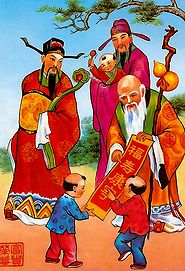
One often encounters the “Fúlùshòu” 福禄寿 (literally: happiness, salary, longevity) icon: three figures often shown together and used as an upbeat decoration for festive occasions. The picture at the right is from a yearly almanac of lucky and unlucky days.
The three (referred to as “stars” or xīng 星) are the “Fú” 福 or Happiness Star (with the kids), the “Lù” 禄 or Salary Star (with the embroidered patch on the belly of his robe and the official’s hat, marked by the extensions on the side), and the “Shòu” (longevity) Star (with the high head). The Shòu 寿 Star or “god of longevity,” with his high head, often occurs in decorations by himself. (All three have names and stories if one looks far enough. You don’t want to know.)
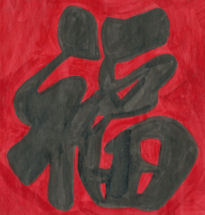
Fú
福 character written by Nina A. LY, UCSD-ERC Class of 2016, by permission.
In this particular picture, the figure holding the "happiness/fecundity" baby is given an official’s hat, although a lower-ranking one than that of the man representing "salary." The banner held by the god of longevity says "Happiness, longevity, health, tranquility" (Fú Shòu Kāng Níng 福寿康宁/ 福壽康寧).
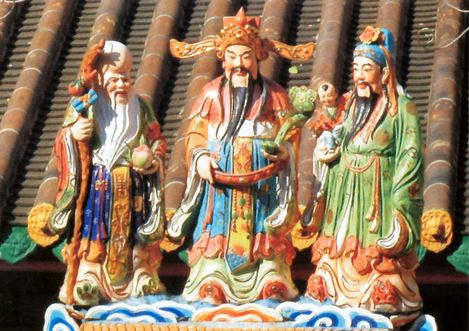
Fúlùshòu on a Taiwan Temple Roof
The motif is found everywhere in China. The picture at left shows a ceramic triad uses as decoration on a temple roof. The one at right below is a traditional woodcut print of the kind that might be pasted over a rural family altar. It shows each figure standing on a decorative distortion of his associated happiness (right to left: fú 福lù 祿shòu 壽 as butterflies flutter overhead. The central figure (Lù) caries a tablet reading “May the celestial ministers bestow happiness ”(Tiānguān cì fú 天官賜福).
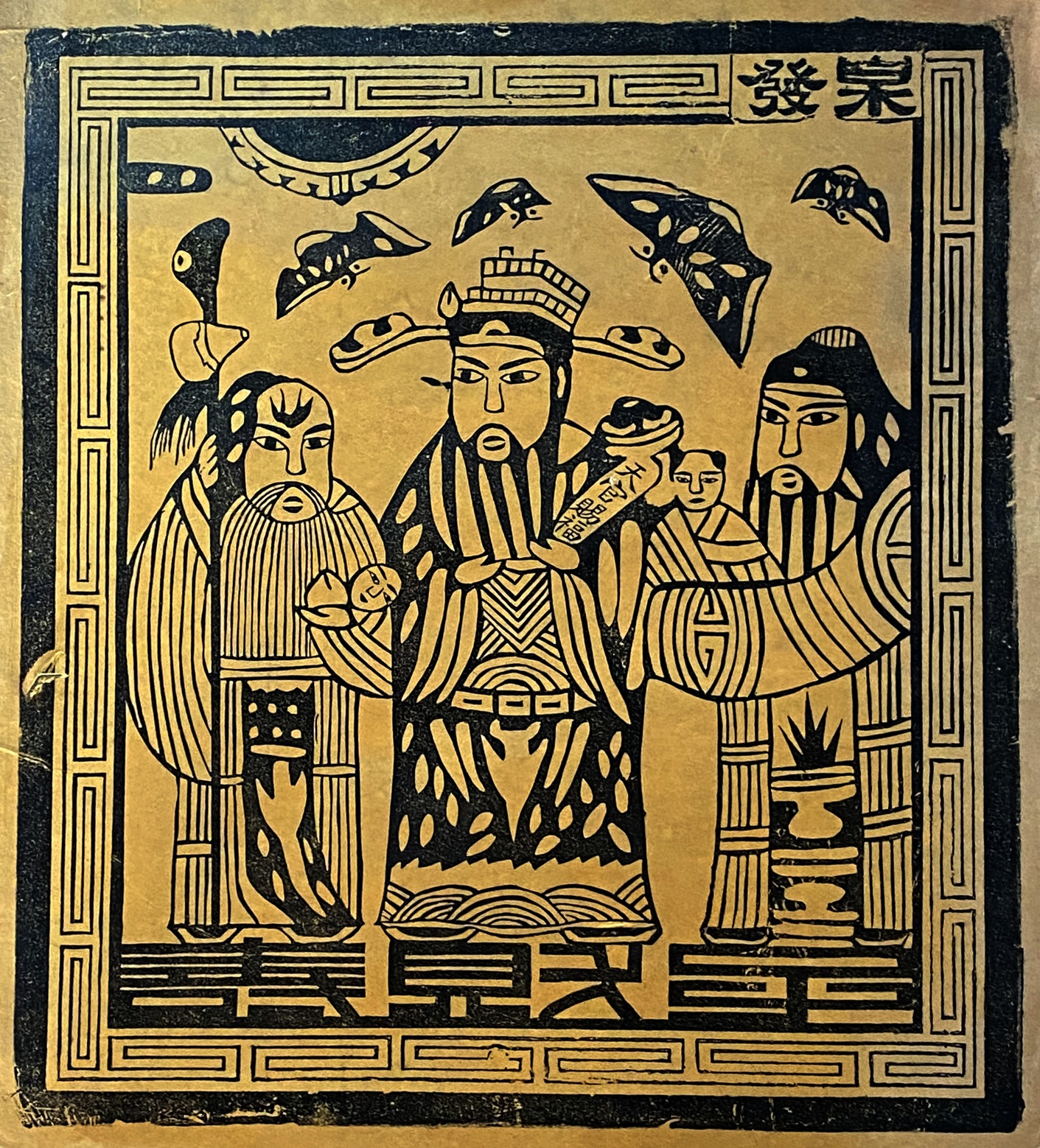
Fúlùshòu Folk Woodcut (Click it for a much bigger one you can print out for use as a wall charm.)
(If three blessings are not enough for you, there is also a conventionalized set of five. Click here for details.)
The quite different picture below combines many common symbols with the same general thrust as the “Fúlùshòu” triad above. It is from a studio called Yángliǔqīng 杨柳青, located in what is today Tiānjīn 天津 municipality in northern China. The studio has been famed for several centuries for producing brightly colored —some would say startlingly garrish— paper prints used for household decoration at New Year.
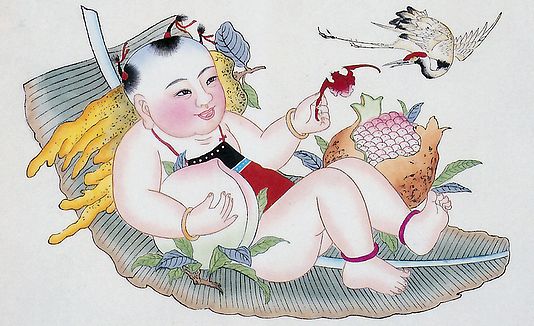
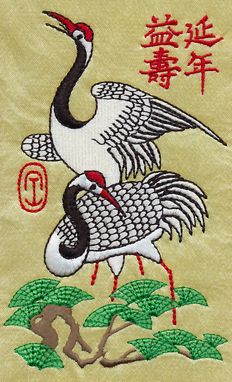
Here are some of the symbols shown in this print:
- The child itself, lying on the leaf, symbolizes fertility and progeny (and, of course, happiness).
- Behind the child’s left knee is a pomegranate, which, like the child itself, symbolizes fertility and progeny, since it is full of seeds (zǐ 子), similar in sound to the word for children (also zǐ 子).
- The child holds a bat, symbolizing happiness (since the words bat 蝠 and felicity 福 are both pronounced fú in Mandarin).
- The child’s pillow is a fingered citron (Citrus medica sarcodactylis) or “buddha-hand” fruit (fóshǒuguā 佛手瓜 or fóshǒugān 佛手柑), symbolizing happiness.
- In the child’s right arm it clutches a peach, symbolizing longevity.
- In the sky flies a crane, another symbol of longevity, especially when combined with pine, a long-lived tree, as in the embroidered birthday greeting shown at the right.
- The child’s red garment is of no special significance in itself. It is a kind of apron, usually called a “stomacher” in English and was used to cover the front of a toddler so that malign breaths could not get into the navel, but in such a way that the child’s bottom remained uncovered for convenient emptying. Stomachers symbolize children in art, but today stomachers appear outside of art largely as costume accessories of spirit mediums, the “children” of their possessing gods.
- The redness of the stomacher, however, does have significance, for red is an inherently “lucky” and exorcistic color, much used for weddings, New Year celebrations, and other happy occasions. In funerals a tiny patch of red is pinned to mourning apparel to fend off the infelicity of the event. At New Year, those born in the dawning animal year —see Heaven Stems & Earth Branches— are considered to be entering a dangerous period, and in North China often wear exorcistic red (even red underwear).
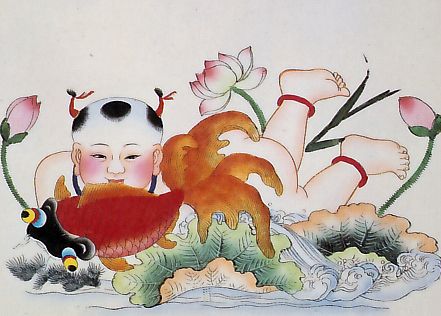
In some similar pictures, like the one at the left, the child is represented with a fish (yú 鱼), a symbol of surplus and abundance (yú 余), again because of sound similarity, like the bats and the seeds. The symbolism carries into other spheres, so that fish becomes a favored New Year food or even gift, as people wish each other abundance in the year to come.
To see a hundred children hatching out of a pomegranate, click here.
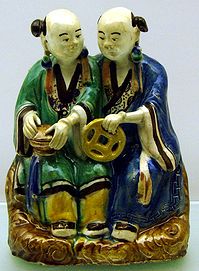
Closing Quiz Questions:
In this little XIXth-century statue from the famous Cantonese Shíwān 石湾 ceramics workshop, one figure holds a monk’s begging bowl full of bats. The other holds an odd disk. After reading this page, you can easily answer the following three questions:
- Why bats?
- What’s the disk?
- Who the dingdong are these two people, anyway?
Return to top.
Picture Sources:
- The embroidery of cranes is from a Hong Kong birthday card.
- The Yángliǔqīng prints on this page are from Naiomi SZETO & Valery GARRETT 1990 Children of the gods: dress & symbolism in China. Hong Kong: Hong Kong Museum of History.
- The Yángliǔqīng prints in the footnote and on the next page are from PĀN Yuánshí & WĀNG Lìxiá 潘元石、汪立峽 1976 Yángliǔqīng bǎnhuà. 楊柳青版畫。 (Woodblock prints from Yángliǔqīng.) Taipei: 雄獅圖書公司. Footnote: P. 50-51. Next page: Pp. 134-135, 138-139.
- The money tree and roof tiles are from lost sources.
- One Fúlùshòu is from the cover of a street almanac.
- The ceramic figurine is from the collection of the Hong Kong Museum of Art.
- The liquor bottle is from my local liquor store.
- The buddha’s hand fruit on the next page is an unidentified internet photo.
- The Pomegranate photo on the next page is by me, as are all photos on the “exasperated excursus” footnote page.
- The woodcut charm is from a private collection.













